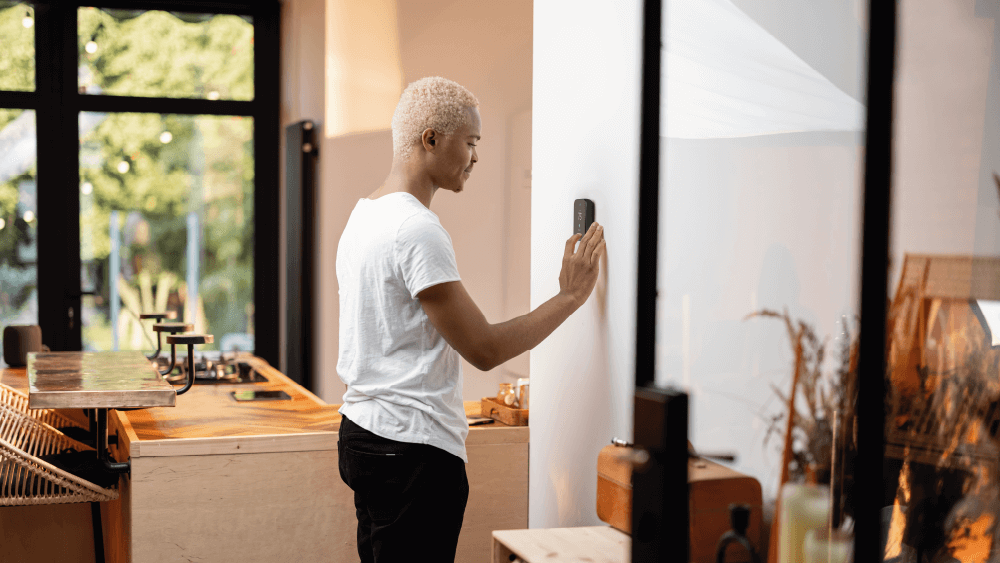Thermostat is one crucial piece of equipment in any home. Therefore, when it comes to installing a thermostat (be it a smart thermostat like Cielo or a simple programmable one), choosing the right location is highly important. It ensures the accuracy of your home temperature and can help keep your energy costs low.
Incorrect thermostat placement can cause your HVAC system to run when it doesn’t actually need to, unnecessarily using up more energy. In particular, one of the unfavorable places you can position a thermostat is near the kitchen. The fluctuating kitchen temperature will significantly disrupt its readings and affect your home climate.
Let’s take an in-depth look at why thermostat placement matters and what putting one near your kitchen could do to your comfort level and energy bill.
Why Should You Avoid Placing Your Thermostat Near the Kitchen?
Your thermostat reads your home’s ambient temperature and sends signals to your HVAC system to maintain your desired settings accordingly. External factors such as heat and sunlight can affect the thermostat reading. Your thermostat may sense it is warmer or cooler than it actually is, making your unit either run for too long or not enough to achieve your set temperature.
While it may be tempting to place your thermostat near the kitchen for easy access and control, it may not be the best choice. Your kitchen is the warmest place in your home due to all the heat that results from cooking and baking. It is also quite humid there as steam from the cooked food increases the air moisture level.
If you install your thermostat in the kitchen or nearby area, it will register a higher temperature than the rest of your home. The thermostat will signal your HVAC system to continue cooling even when the other rooms have achieved the set temperature.
As a result, your unit will run longer than required, and this will cause an unnecessary increase in your bills. Not to mention the increased wear and tear affecting your unit’s efficiency in the longer run.
Similarly, in winter, the thermostat in the kitchen will sense that your home has achieved the set temperature. It will signal your heating unit to turn off, and you will be left shivering in other rooms.
Other Places to Avoid When Installing Your Thermostat
When installing your thermostat, make sure your thermostat isn’t in any of these unfavorable locations.
1. Near Drafty Doors and Windows
The fluctuating temperature near the drafty doors and windows will result in inaccurate thermostat readings, causing your unit to cycle on and off repeatedly. This will affect your HVAC efficiency and your home environment.
2. Near Electrical Devices
You should avoid installing your thermostat near electrical devices such as lamps or TV sets. These devices emit heat which can throw off the thermostat reading, and you can end up with a massive electricity bill. Here are some tips to lower your energy bills.
3. Under Direct Sunlight
It’s best to avoid placing your thermostat where direct sunlight falls on it, such as near an east or west-facing window. Prolonged exposure can heat up the device, interfering with its ability to read temperature accurately and operate as intended.
4. On Exterior Walls
One common mistake people make is choosing an exterior wall as the location for their thermostat. A thermostat on an exterior wall may be influenced by outside weather conditions, which can affect how it measures the overall temperature of your home.
5. In Hallways
While your hallway is free from drafts or heat sources, it still isn’t an ideal thermostat location. They are long, narrow with little to no air circulation, and don’t reflect your home’s average temperature. Plus, you don’t spend much time in the hallways. So, placing your thermostat there means your thermostat won’t be reading the temperature of areas you actually want to heat or cool.
6. Near Supply Vents
Installing a thermostat too close to an air vent can throw off the thermostat reading. The reason is that the hot/cold air from the vents is different from the temperature in your home. This causes ghost readings, causing your bills to skyrocket.
Best Location to Install Your Thermostat
The best place to put your thermostat is the interior wall in a common area, such as your living room. This location better reflects your home climate, and your thermostat will take accurate readings without being influenced by any external factors.
When installing your thermostat, you should also consider the height at which it will be placed. Ideally, it should be 52-60 inches above the floor. As warm air rises, installing it at a height of more than 60 inches can produce incorrect readings. Similarly, a thermostat that sits below 52 inches will result in a lower than actual reading.
If your thermostat is not installed in the correct place, it’s better to move its location. You will have to call the HVAC technicians, as this will require running the wires from your HVAC to the new position.
In Conclusion
For peak HVAC efficiency and cost savings, choosing the right spot for your thermostat is the key. It is best to avoid areas that can influence your thermostat’s accuracy. For instance, the kitchen isn’t an ideal location, as high-heat production from cooking can cause your thermostat to register a false reading of your home temperature.
Also, it’s best to avoid installing your thermostat in direct sunlight or near drafty doors and windows. The best place for a reliable and accurate reading is along an interior wall in an area that you frequently use in your home. By following these guidelines, you can maintain a comfortable temperature throughout your home while lowering your electricity usage.

